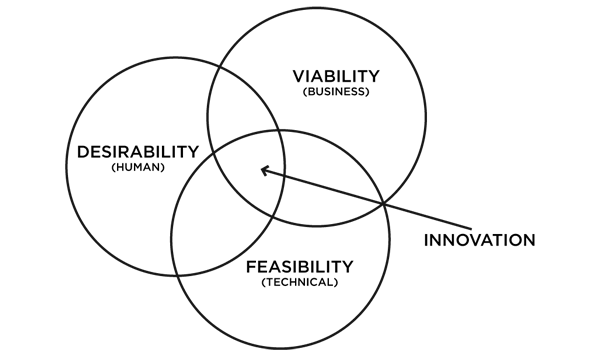In one of my previous posts I discussed the crucial distinction between need and solution. Innovation is about matching these two components – i.e. solving a customer problem (desirability) through a viable business model, leveraging feasible products and services – in a novel way. It’s important to note that solutions are not represented by products and services solely, but by entire business models creating, delivering and capturing value.
Let’s consider some different cases that can occur:
Need: known – Solution: known
Customer problem and desired solution are properly specified. As a clear objective for solution development has been defined, the project can be planned and executed straightforward. This is usually accomplished by choosing a waterfall-approach. Known-known cases typically refer to improvements and incremental innovation for existing markets.
Need: known – Solution: unknown
This case applies to identified needs or ‘jobs-to-be-done’ that can either be well anticipated through upcoming trends or that haven’t been able to be solved yet (e.g. cures for life-threatening diseases). But it also describes an existing market, where customers lack a tailored solution to feel well-served. Appropriate solutions often start off with novel business models or technologies for ill-served minorities and end up in disruption of the entire market. As development of novel solutions is based on evolving requirements, agile methods should be the preferred choice.
Need: unknown – Solution: unknown
That’s the most challenging case: creating a new business by entering a new market. Unknown markets imply the highest level of uncertainty, mainly for the following reasons:
• Data does not yet exist. There is no market research or time-series data available.
• There are no comparable solutions. It’s almost impossible to find good analogies to base estimates on.
• Existing customers provide bad data. They tend to discount and denigrate innovations because they can compare it only to solutions they are accustomed to consuming.
• New customers provide unreliable data. Customers are notoriously bad at visualizing how they would use solutions that either they are not yet using or do not yet exist. Consequently, the predictive value of customer research into emerging markets is slow. Moreover, there are predictably irrational reasons why consumers say one thing and actually do the other.
• Firms operate as parts of complex systems, featuring non-linear behavior. Therefore it’s inherently impossible to predict how these systems evolve and how innovative ideas spread. The longer the time horizon for an innovation activity the higher the uncertainty whether predictions and visions eventually will prove true.
Unlike exploitation of existing markets, exploration of new markets requires an emergent and experimental strategy. It usually starts with a vision, i.e. an idea about a novel need-solution fit with breakthrough potential, and consists of the following basic steps:
1. The vision needs to be translated into hypotheses / assumptions. In case of bold ideas, predictions are based on ‘wild guesses’ and are mostly wrong. Little visions have few unknowns. Big visions have lots of unknowns.
2. Hypotheses are tested through appropriate experiments. Risk prioritization in terms of uncertainty and impact helps target the most important unknowns early. Particularly, the most critical assumptions about addressed need and the corresponding latent demand are mandatory to become validated first. This validation can be narrowed down by involving potential customers upfront through direct conversations and indirect observations. Eventually, however, probing of critical hypotheses is carried out by presenting a minimum viable solution, providing maximum amount of validated learning with least effort and cost. It usually addresses early adopters (e. g. lead customers) in order to obtain customer feedback. “Put your new business model to the test“, as Saul Kaplan suggests. In the end, customer adoption determines innovation success.
3. Iterated learning through comparison of predictions and outcomes. If outcomes don’t follow predictions, invalidated assumptions need to become revised or abandoned. According to Eric Ries, pivots are defined as changes in strategy without a change in vision. David Aycan even suggests to perform multiple experiments ‘in tandem’ to create more confidence in core variables.
Tim Kastelle has previously pointed out that experimentation is an essential part of Innovation Competence in a world with accelerated change and complexity. Indeed, research indicates: the stronger a company’s growth performance, the more likely it will prefer experimentation as the first step to identify an opportunity. Innovation through experimentation has been greatly discussed in Peter Sims’ book Little Bets. One of his key points is:
Little bets are for learning about problems and opportunities while big bets are for capitalizing upon them once they’ve been identified.
Sims advocates experimental innovators, discovering innovation through an emergent process, rather than trying to formulate and pursue bold ideas. This search process can be visualized as movement in an innovation fitness landscape. Depending on the complexity of the innovating firm’s environment, the landscape is more or less rugged, exhibiting hills of different heights (fitnesses). Translated to innovation terminology, each hill characterizes an opportunity with a certain business potential.
Fitness Landscape – Source: http://cairnarvon.rotahall.org
The innovating firm is located somewhere at the slope of a particular hill. Exploiting the core business means climbing up this hill to the peak along an optimum gradient in continuous innovation steps. If the peak is reached, there is no more potential to unlock and the firm gets stuck.
However, if the firm strives to explore new business opportunities on the longer term, with even higher potential (peaks), it needs to be willing to leap across the valleys in between. Vision is future-oriented and reflects the ability to spot promising peaks in a changing landscape. It provides the motivation and a rough direction for this leap. Thinking too small leads to a short leap, resulting in an inability to leave the current hill (paradigm). The fewer unknowns a vision contains the better the search process can be localized. Therefore, adequate understanding of customer needs can feed the development of an appropriate solution and help increase the likelihood for a successful leap. In case the leap has reached the slope of the targeted hill, it’s up to the following iterations to refine towards the best gradient to scale the business. If the leap fails to reach the hill and ends up in a valley, underlying assumptions are required to be reconsidered. This is the basis for an adjusted solution to be proposed to the test market. As mentioned above, involving appropriate consumers to test and refine the solution may increase likelihood of market success. A changed strategy, however, should still be committed to the intended purpose, rather than being focused on chasing quick money.
While finishing this post, I ran across Ash Maurya’s interesting blog by chance. He approaches the search process of entering new ventures from a quite similar angle (I particularly recommend reading this post). Maurya distinguishes two consecutive experimentation stages:
First stage: Pivoting
This stage aims at qualitatively identifying the right direction (strategy, business model) by validating problem-solution fit and market demand. It addresses the following questions:
• Do we have a problem worth solving?
• Have we built a solution people really want?
Second stage: Optimization
Once the right direction has been identified, optimization experiments on a quantitative basis are leveraged to go faster and more efficient towards the defined direction. The key question to be addressed for this stage: • How can we accelerate growth?
Takeaway
Emergent creation of a new businesses by exploring breakthrough innovation opportunities requires a well-positioned leap followed by quick iterative refinement in order to identify the gradient for scale. Be sure to
• think as big as necessary to leave existing regimes.
• act as small and informed as possible to avoid running out of budget.
• learn and adjust as quickly as capable without losing sight of purpose.
Or briefly: hold strong visions weakly!










[…] Make lots of little bets. […]
[…] 7. Make lots of little bets. […]
[…] 7. Make lots of little bets. […]
[…] merge these increasingly upcoming frameworks. The Lean Design Thinking process may help to explore entirely novel innovation opportunities – where both market/customer needs as well as solutions are unknown at the outset – […]
[…] merge these increasingly upcoming frameworks. The Lean Design Thinking process may help to explore entirely novel innovation opportunities – where both market/customer needs as well as solutions are unknown at the outset – […]